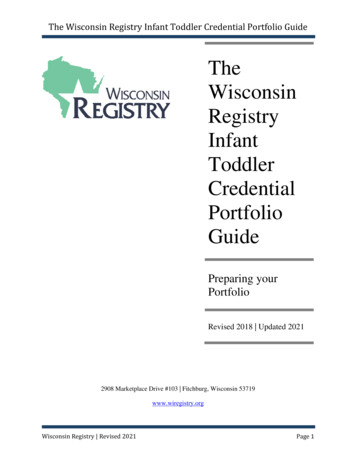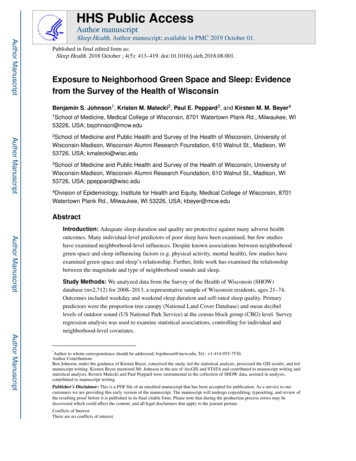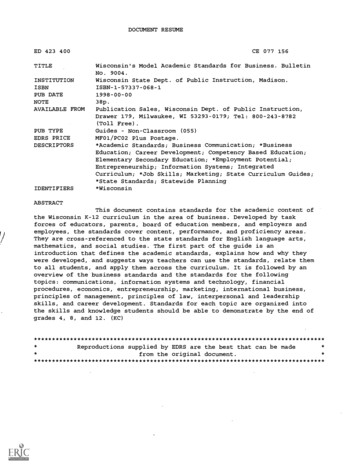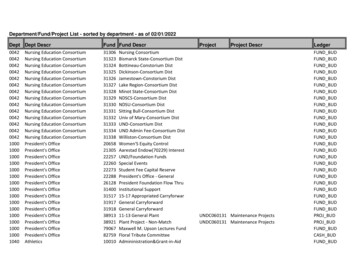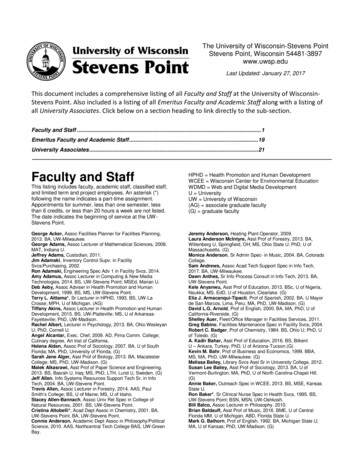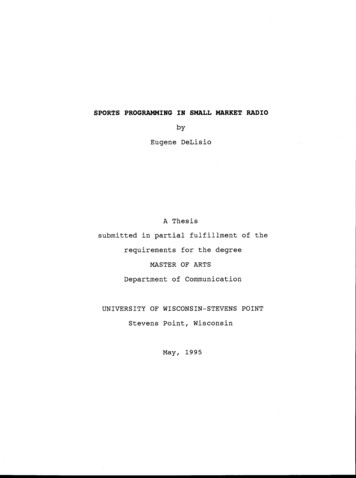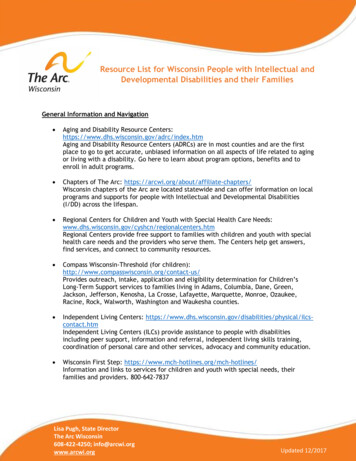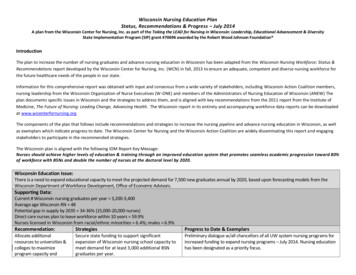
Transcription
Wisconsin Nursing Education PlanStatus, Recommendations & Progress – July 2014A plan from the Wisconsin Center for Nursing, Inc. as part of the Taking the LEAD for Nursing in Wisconsin: Leadership, Educational Advancement & DiversityState Implementation Program (SIP) grant #70696 awarded by the Robert Wood Johnson Foundation IntroductionThe plan to increase the number of nursing graduates and advance nursing education in Wisconsin has been adapted from the Wisconsin Nursing Workforce: Status &Recommendations report developed by the Wisconsin Center for Nursing, Inc. (WCN) in fall, 2013 to ensure an adequate, competent and diverse nursing workforce forthe future healthcare needs of the people in our state.Information for this comprehensive report was obtained with input and consensus from a wide variety of stakeholders, including Wisconsin Action Coalition members,nursing leadership from the Wisconsin Organization of Nurse Executives (W-ONE) and members of the Administrators of Nursing Education of Wisconsin (ANEW) Theplan documents specific issues in Wisconsin and the strategies to address them, and is aligned with key recommendations from the 2011 report from the Institute ofMedicine, The Future of Nursing: Leading Change, Advancing Health. The Wisconsin report in its entirety and accompanying workforce data reports can be downloadedat www.wicenterfornursing.orgThe components of the plan that follows include recommendations and strategies to increase the nursing pipeline and advance nursing education in Wisconsin, as wellas exemplars which indicate progress to date. The Wisconsin Center for Nursing and the Wisconsin Action Coalition are widely disseminating this report and engagingstakeholders to participate in the recommended strategies.The Wisconsin plan is aligned with the following IOM Report Key Message:Nurses should achieve higher levels of education & training through an improved education system that promotes seamless academic progression toward 80%of workforce with BSNs and double the number of nurses at the doctoral level by 2020.Wisconsin Education Issue:There is a need to expand educational capacity to meet the projected demand for 7,500 new graduates annual by 2020, based upon forecasting models from theWisconsin Department of Workforce Development, Office of Economic Advisors.Supporting Data:Current # Wisconsin nursing graduates per year 3,200-3,400Average age Wisconsin RN 48Potential gap in supply by 2035 34-36% (15,000-20,000 nurses)Direct care nurses plan to leave workforce within 10 years 59.9%Nurses licensed in Wisconsin from racial/ethnic minorities 6.4%; males 6.9%Recommendation:StrategiesProgress to Date & ExemplarsAllocate additionalresources to universities &colleges to maximizeprogram capacity andSecure state funding to support significantexpansion of Wisconsin nursing school capacity tomeet demand for at least 3,000 additional BSNgraduates per year.Preliminary dialogue w/all chancellors of all UW system nursing programs forincreased funding to expand nursing programs – July 2014. Nursing educationhas been designated as a priority focus.
infrastructure to decreasewait lists & double capacityby 2020.State Collaborative formed; WI Nurses Association (WNA)leading efforts toanalyze & make recommendations on increasing number of NP graduates instate. Barriers identified.Implement innovative programs, partnerships andstrategies to remove barriers to access foreducation including funding and increasedemployer support.Evaluate the expanded use of evidence-basedclinical simulation as a teaching method to thefullest extent possible in both educational &practice settings.New MSN in Health Systems Administration offered by Milwaukee School ofEngineering Nursing Program.New partnership - Bellin College Nursing Program & Medical College ofWisconsin (MCW) for interprofessional education opportunities, beginningJune, 2015. Also working with MCW to explore funding for interprofessionalgrants, including collaboration with Oneida nation.New 53 million UW Madison School of Nursing opening Fall, 2014 with stateof the art interprofessional simulation classrooms & to support 30% growth infaculty, research programs and enrollment.Milwaukee School of Engineering Nursing Program partnership with MedicalCollege of Wisconsin for interprofessional simulation learning pilot.Bellin College & Medical College of Wisconsin adding space to currentsimulation area for inter professional simulation as well as for standardizedpatients. Over 1million dollars being spent on expansionInvestigate possibility of BSN completion programs inWisconsin Technical College System.Improve retention & graduation rates of nursingstudents, including students fromunderrepresented populations, through theimplementation of comprehensive strategies byWisconsin nursing education programs.2012 WI Education Survey indicates ADN student diversity mirrors Wisconsinpopulation.SIP grant diversity tool kit in development to support racial/ethnic minoritiesto graduation.WI Diversity Assessment Tool in development.2012 WI Education Survey indicates student diversity mirrors that ofWisconsin population (based on 83% schools reporting).Implement academic-practice partnerships toestablish dedicated educational units (DEUs) fornursing in practice settings that expedite clinicalpracticums.Expand early student recruitment efforts to theDiscover Nursing Camp - Week long pre-college experience for high school
nursing professions with middle and high schoolstudents through a variety of programs (e.g.,summer nursing immersion experiences, such asthe Discover Nursing program).Create partnerships with high school basedCertified Nurse Assistant (CNA) programs toconnect high school students to RN programs.Collaborate with university STEM Programs(Science, Technology, Engineering & Math) tocreate curriculum related to nursing as a careeroption.Explore opportunities to partner to promoterecruitment of high-achieving students to thenursing profession.students at Milwaukee School of Engineering Nursing ProgramMultiple colleges/ organizations offering camps to increase the interest ofmiddle and high school students in health care careers, i.e. Northeast WIArea Health Education Centers, Bellin College.Accelerated 2nd Degree BSN offered by Milwaukee School of EngineeringNursing Program for students with previously earned BS or BA degrees;compressed 16 month program.Accelerated 2nd Degree BSN offered by UW Oshkosh College of Nursingoffered as hybrid program in 12 months.Wisconsin Education Issue:Currently 54.1% of nurses licensed in Wisconsin have a BSN, or higher degree. Wisconsin will need to increase the educational capacity of BSN completionprograms to support seamless academic progression options to meet the goal of 80% BSN by 2020.Supporting Data:BSN degree or higher 54.1%BSN degree only 43.8%Number of ADNs licensed in Wisconsin to advance 28,402Nurses licensed in Wisconsin from racial/ethnic minorities 6.4%; males 6.9%Recommendations:StrategiesProgress to Date & ExemplarsTriple the number of ADNnurses completing a BSN orhigher degree annually by2020.Implement dual track enrollment betweentechnical colleges and 4-year institutions tofacilitate students’ ability to attain a BSN or higherdegree.UW Milwaukee BSN leadership &community health nursing courses beingoffered at Milwaukee Area Technical College.Remove identified barriersto academic progressionwhich include: funding,access and timeconstraints.Assist ADN graduates fromunderrepresentedpopulations to achieveSeek state funding for the expansion of capacity forface-to-face and online BSN completion programs.Concordia University of WI offers dual enrollment options.Articulation agreements in place with all WI Technical School Systemschools & the Wisconsin BSN @ Home programPreliminary dialogue w/all chancellors of all UW system nursing programs forincreased funding to expand nursing programs – July 2014. Nursing educationhas been designated as a priority focus.New online BSN completion at UW Stevens Point in Wisconsin as part of BSN@ Home program
BSN or higher education.Expand the shared curriculum & sharedcompetencies models and accelerated curriculumoptions.All 16 WI Technical College System nursing programs have sharedcurriculum & shared competency model in place since 2006.Six UW Campuses share common core online RN to BSN curriculum entitledBSN@HOME.Accelerated 2nd Degree BSN offered by Milwaukee School of EngineeringNursing Program for students with previously earned BS or BA degrees;compressed 16 month program.Accelerated 2nd Degree BSN offered by UW Oshkosh College of Nursingoffered as hybrid program in 12 months.Evaluate & implement innovative push-pull models,with established partnerships between ADN andBSN programs to facilitate students furthering theireducation, including specific models to identify andsupport students from underrepresentedpopulations.2012 WI Education Survey indicates 33% increase in RN to BSN studentenrollments from 2011 (based on 83% schools reporting).UW Milwaukee College of Nursing partnership with Milwaukee AreaTechnical College with nursing advisor of color on staff to work with ADNstudents to enter BSN programsSome technical colleges have University representation on their campus atkey times and/or on a regular basis for advising students.Annual BSN & higher “educational fairs” with representation from BSNprograms on the technical college campuses.Develop a one credit professional course offeredduring the ADN program to include content oncareer pathways in nursing and academicrequirements.Assess educational status of nursing staff byhealthcare systems by 2014, develop andimplement plans by December 2015, and monitorachievement of progress annually.Foster innovative strategic regional partnershipsbetween schools and healthcare systems toadvance nursing education opportunities, includingWI Technical Colleges System new Bridge Program for Paramedics to RNCareer pathways & academic advancement integrated into the ADNcurriculum in Fundamentals of Nursing and Nursing Management &Professional Concepts in WI Technical School System.Southwestern Technical College is developing a ‘nursing trajectory course’or an orientation for all WTCS students to take while in ADN Program.Statewide survey of health systems in development in partnership w/WONE, WCN & Administrators of Nursing Education in WI (ANEW)Rural urban pilot programs to advance nursing education partnerships indevelopment.
increased tuition support and “time to study” (flextime) options.New RN to BSN Flex Option in place at UW Milwaukee College of Nursing.New BSN Completion Program offered by Bellin College Nursing Program forBellin Health employees; starting January 2015New partnership w/ Marquette University College of Nursing, Children'sHospital of WI and two community organizations to provide nursepractitioners for community-based clinics.Seek private dollars from foundations, corporationsand individuals for scholarships for undergraduateand graduate education to accelerate academicprogression.Continue seamless academic progression andsupport for LPNs to achieve ADN or BSN degreecompletion.New partnership w/ Marquette University College of Nursing & Zablocki VAHospital 5million to train nurses for positions at the VA facilities aftergraduation.Wisconsin Funders Network in development to bring together foundations,CNOs & Deans.New partnership w/ Group Health Cooperative South Central WI &Edgewood College of Nursing- 1million for Center for Primary CareInnovation to engage nursing students and graduates in progressive modelsof primary care delivery.LPN Progression program in place which gives credit for prior learning toLPNs.Wisconsin Education Issue:Currently, 0.6% of Wisconsin nurses hold a doctoral degree in nursing. To assure an adequate faculty supply, along with increasing diversity, Wisconsin will needto double the number of nurses with doctoral degrees by 2020.Supporting Data:PhD degrees 0.4%DNP degrees 0.2%Average age of Wisconsin faculty 53Faculty plans to retire within 4 or less years 33%Insufficient capacity in second degree programs 61% rejected applicantsRecommendation:Strategies:Remove salary inequitiesfor nurse faculty to providemarket competitionbetween practice &education to recruit /retainfaculty and researchers.Explore and expand creative public-private fundingmodels to support additional nurse facultypositions to increase student enrollmentIncrease dual faculty positions between twoeducational institutions, or an educational programProgress to Date & Exemplars2012 WI Education Survey indicates increase in full-time faculty across allinstitutions.Nurses for Wisconsin: Lead, Teach, Learn 3.2million WI WorkforceIncentive grant for loan forgiveness for pre-post doc students in return for 3year teaching commitment.Bellin College & Bellin Health (Green Bay) employees will co-teach coursesfor RN to BSN Completion Program beginning January, 2015.
and a clinical agency.Rural Black River Falls Hospital is exploring having MSN preparedemployees teaching RN to BSN courses on site.Increase DNP & PhDcapacityActively recruit faculty from underrepresentedgroups.Expand & enhance loan forgiveness and traineeshipprograms for nursing faculty.Initiate new programs or expand existing programsNurses for Wisconsin: Lead, Teach (above)New DNP program at Henry Predolin School of Nursing -Edgewood College,MadisonNew post MSN-DNP Executive Program for Nurse Leaders at MarquetteUniversity, MilwaukeeReferences:IOM (Institute of Medicine). (2011). The Future of Nursing: Leading Change, Advancing Health. Washington, DC: The National Press. Retrieved tional Council of State Boards of Nursing. (2013). 2012 Annual Report. Retrieved from https://www.ncsbn.org/NCSBN AnnualReport2012 5.pdfWalsh, T., Udalova, V. & Winters, D. (2011). Wisconsin Registered Nurse Supply and Demand Forecasting: Results Report 2010-2035. Wisconsin Department ofWorkforce Development, Office of Economic Advisors. Retrieved fromhttp://worknet.wisconsin.gov/worknet info/projects/rn forecasting/results report printer friendly.pdf.Wisconsin Center for Nursing, Inc. (2014). Wisconsin Nursing Education and Nurse Faculty: 2012 Survey Results. Retrieved nsin education surveys.htmlWisconsin Center for Nursing, Inc. (2013). Enhancing Diversity in the Wisconsin Nursing Workforce. Retrieved sity int.htmlWisconsin Center for Nursing, Inc. (2013). The Wisconsin Nursing Workforce: Status & Recommendations. Retrieved orce report.htmlWisconsin Department of Workforce Development Labor Market Information (2011). Wisconsin Center for Nursing, Inc. Wisconsin 2011 LPN Survey Summary.Retrieved from http://www.wisconsincenterfornursing.org/nursing survey.htmlWisconsin Department of Workforce Development Labor Market Information (2012). Wisconsin Center for Nursing, Inc. Wisconsin 2012 RN Survey Summary.Retrieved from l
Wisconsin Nursing Education and Nurse Faculty: 2012 Survey ResultsA report from the Wisconsin Center for Nursing, Inc. as part of the Taking the LEAD for Nursing in Wisconsin: Leadership, Educational Advancement & DiversityState Implementation Program (SIP) grant #70696 awarded by the Robert Wood Johnson Foundation The 2011-2012 Wisconsin Educational Survey had responses from 83% of Wisconsin nursing education programs. The following are high levelresults from that survey related to RN to BSN programs, and other aspects of nursing education in Wisconsin. The full report is available in education surveys.htmlFor Wisconsin RN to BSN Programs:Qualified applicantsStudent seatsStudents admittedRejected applicationsNew enrolleesStudents d9551751425% Increase20%NA20%NA33%12%Additional data from the 2012 Wisconsin Education survey results: Increase in # of ADN programs reported in 2012, so data better reflects program capacity.Lack of clinical sites most commonly identified factor limiting admissions to both ADN & BSNMany BSN completion programs indicated unlimited space.Lack of funds to hire faculty &lack of campus resources identified as factors that limited admissionsDiversity of student population in WI programs continues to reflect diversity of the general population.Males consistently underrepresented in all nursing programs in WI.Diversity continues to be greater in ADN programsIncrease in DNP graduates & new DNP student enrollment reported.Decrease in PhD student graduates & new PhD student enrollment reportedIncrease % of full-time faculty noted across all institutions reporting.Gender, race/ethnicity for faculty very different than students.Across all programs, almost all faculty female (95%) & Caucasian (93.5%).
Average age Wisconsin RN 48 Potential gap in supply by 2035 34-36% (15,000-20,000 nurses) Direct care nurses plan to leave workforce within 10 years 59.9% Nurses licensed in Wisconsin from racial/ethnic minorities 6.4%; males 6.9% Recommendation: Strategies Progress to Date & Exemplars Allocate additional resources to universities &

